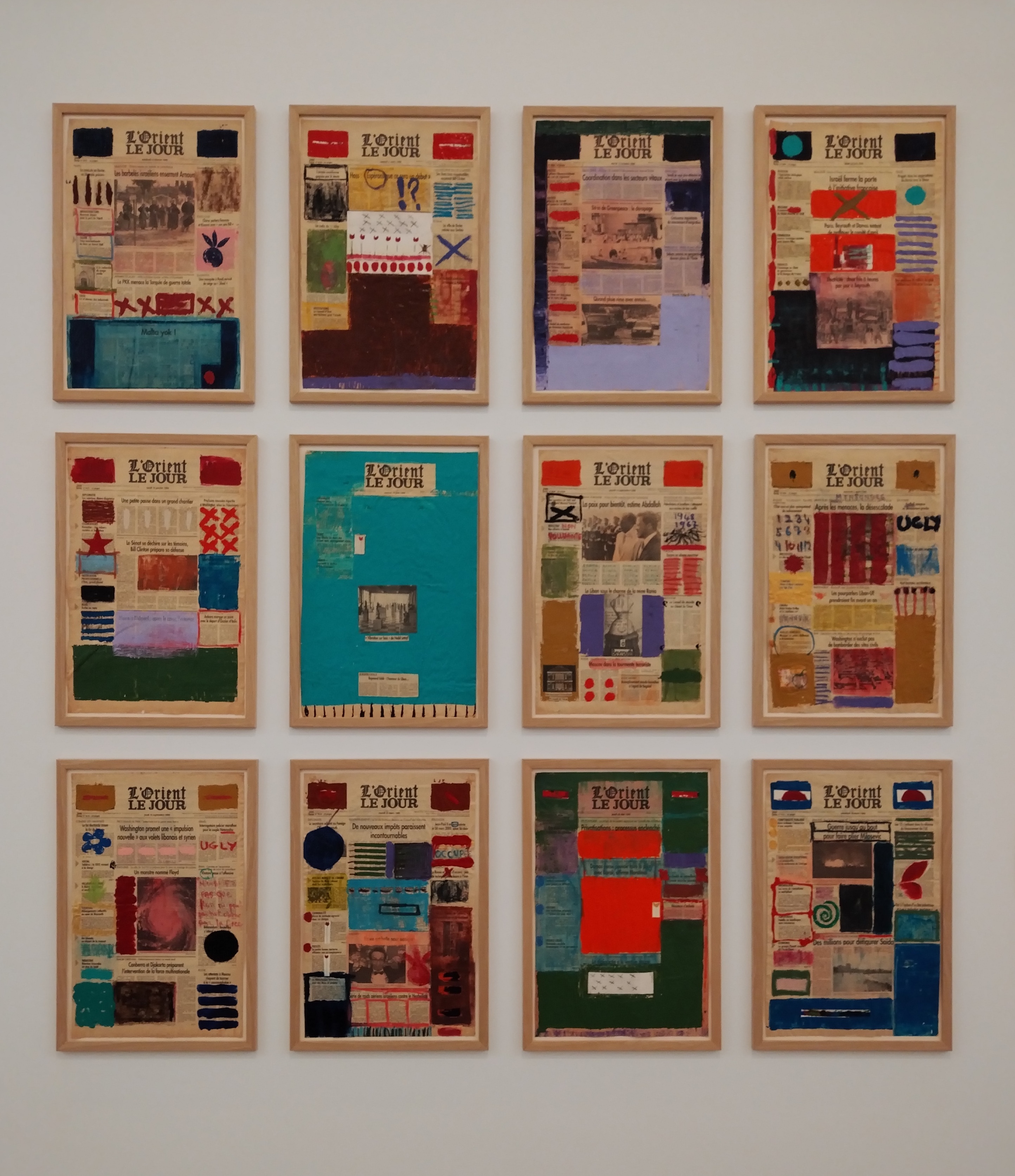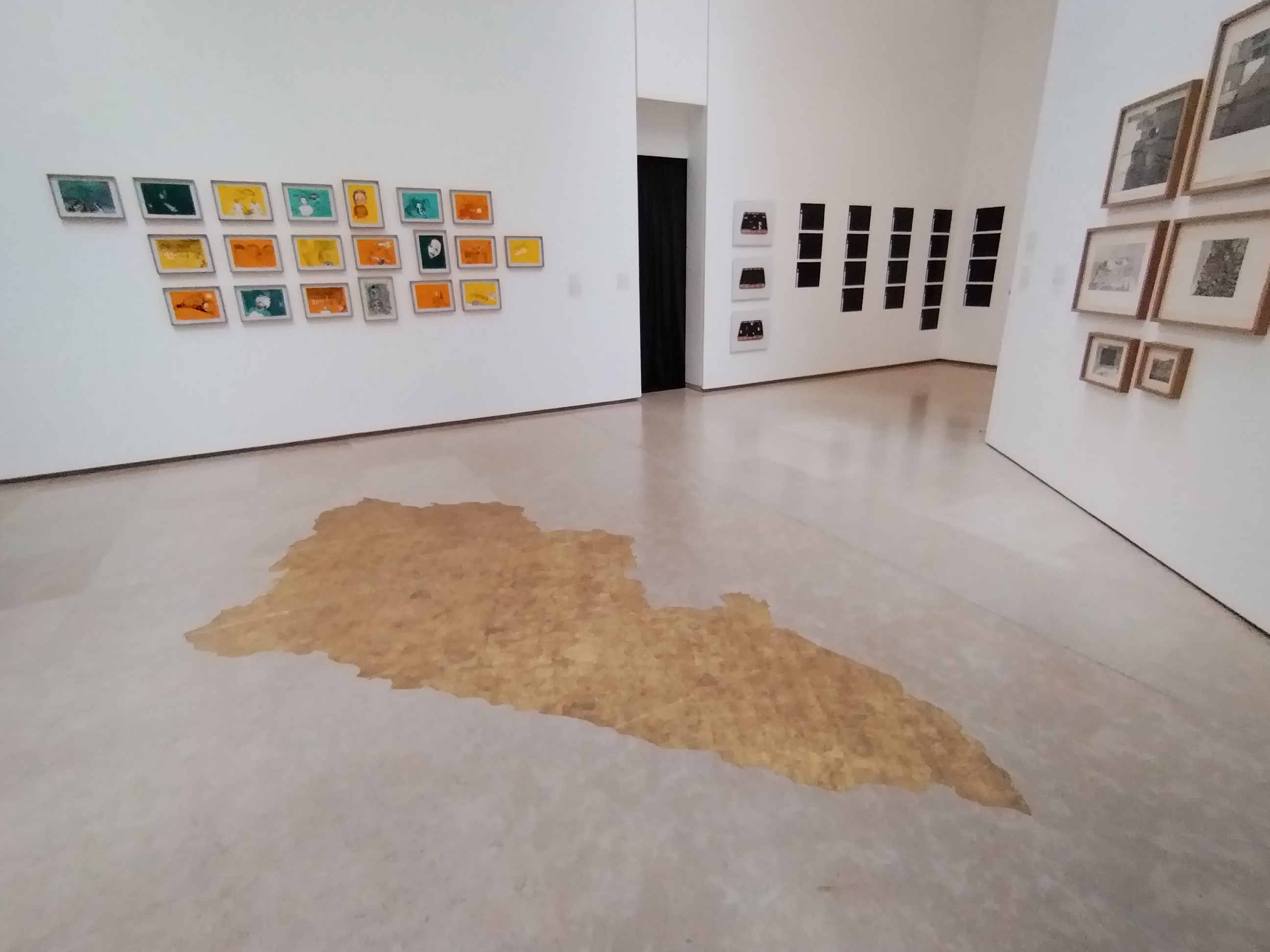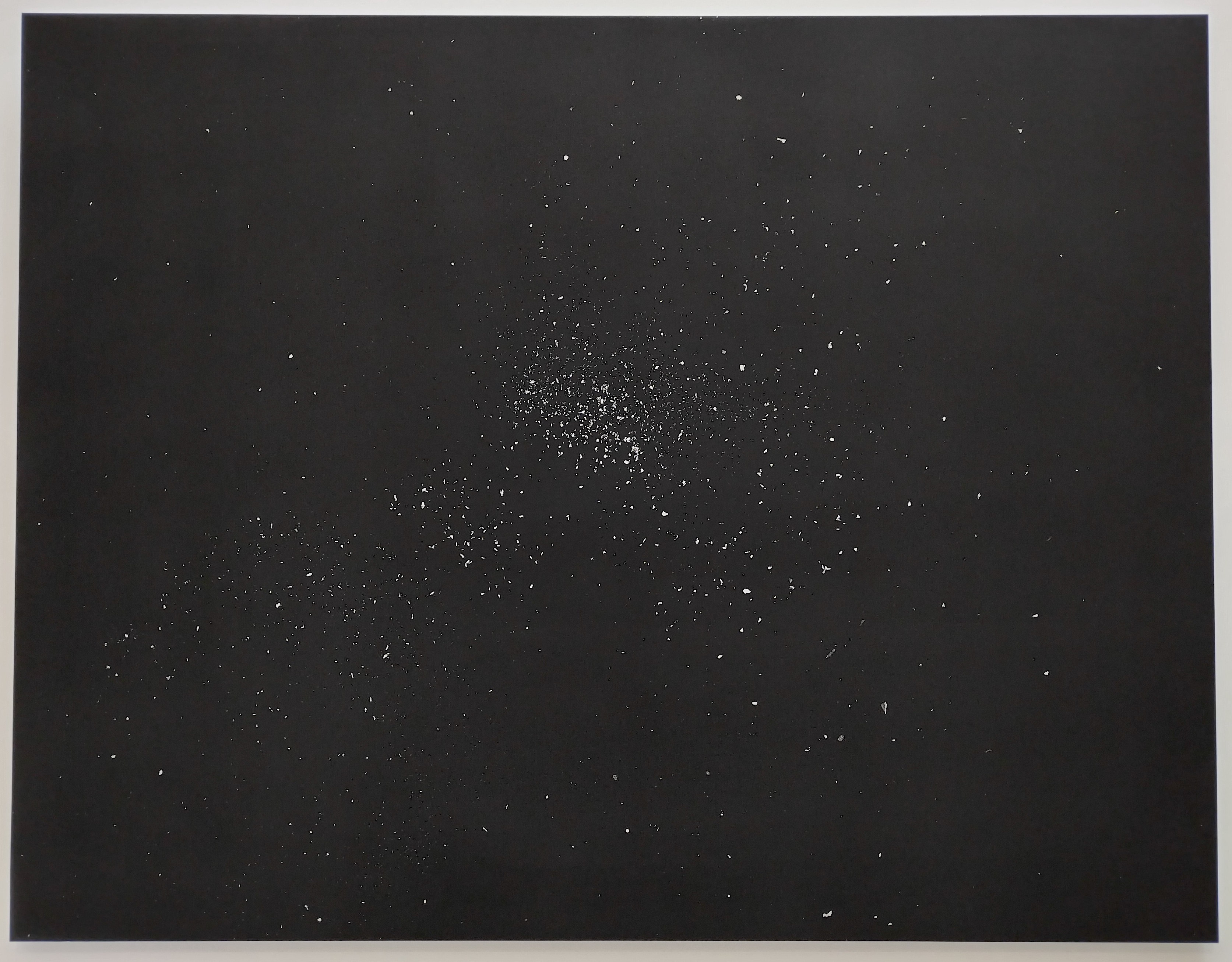This exhibition, "Intimate Garden Scene (in Beirut)," features artworks by sixty-seven artists, including many famous names, and some less familiar ones. The exhibition is part of the Home Works Forum series organized by Ashkal Alwan, and refers back to a seminal 1995 exhibition at the Sanayeh Garden in Beirut. Some of the artists who exhibited then are contributors to this exhibition.
The theme is resolutely Beiruti, avowedly retrospective and in some sense, whether intentionally or not, canon building. The catalogue that accompanies the exhibition, leans into this tendency by including short biographies of the participating artists.1 The wording of these biographies and the labels on the artworks is often idiosyncratic which implies that they were written by the artists themselves. Indeed this is a show of artists in more than one sense. Some of them created, or recreated works specifically for this exhibition, there is no identifiable curator to the exhibition, and no curatorial statement at the entrance or other wall-texts providing an overview, direction or themes for the visitor. As a result, the exhibition is experienced not as a consciously constructed whole, but as a series of individual encounters with individual artists and works. The relationships between them, the reasons why they are there, together, are left to the viewer to construct.
The catalogue includes an introduction which states the artworks and the exhibition is ‘witnessing a time and place marred by the permanence of crisis’,2 and there are shared themes in the responses to crisis that emerge from the constellation of work presented: an emphasis on the discordant experience of individuals, the frangible nature of memory, and an engagement with fictions as a vehicle for communicating lived experiences.

Many of the artworks are about individual stories. Some works employ the intimacy of diaries (such as Laure Ghorayeb (Mini Miniature, 2020-22, fig. 5), Lamia Joreige (Diary of Sleep, 2004) and Jayce Salloum (Full Disclosure, 1992)), while others work with a repetitive aesthetic and reference mass media. Nada Sehnaoui’s Painting L’Orient-Le Jour (fig. 1) engages with both, transforming the public space of the newspaper into the private space of the diary. Sehnaoui paints over the headlines of the daily’s front pages and remakes the public and institutional into private and individual statements: le journal becomes her journal. The series of painted front pages suggests the troubled relationship between individuals and institutions. Although made in 1999, rather than during the more recent crises, this artwork nevertheless seems to address the dissociation of the publicly broadcasted news from individual experience as it is often slow to report events, selective, and blind to the quotidian experience of crisis.
Sidestepping public discourse, many of the artworks approach the representation of memories as retold and revised by people who situate themselves within, after or outside crises. Memory is slippery and experiences during crises are difficult to capture. Ultimately, the past is utterly inaccessible and yet weighs on the present. Nevertheless, artists are called upon as witnesses to testify in the court of history. Many of the most interesting artworks dispute the limits of memory and experience, and resist the role of witness, instead they confront us with necessary even if unreliable visions.

The work of Joana Hadjithomas and Khalil Joreige, Latent Images (fig. 2), tells the story of Abdullah Farah, a fictional photojournalist living during the war. Due to shortages in photographic equipment and materials, Farah was not able to develop all the films that he shot. Instead, he kept a written record of the rolls’ content. These written notes are displayed as white type on a black glossy contact sheet. Photographs of the boxes of undeveloped film rolls are displayed with the contact sheets. The effect is to manifest a set of latent memories, that only Farah knows, and which viewers can only imagine. This offers a layered fictionality since the viewer’s imagination of these scenes is based on the life of the fictional Abdullah Farah whose documentary records are locked away in the fiction of undeveloped film rolls.
Similarly, Walid Sadek’s Letters to Coevals (2023), is a folder containing seven letters he wrote to colleagues in English, here translated into an unidentified Cyrillic language, and are thus illegible and inaccessible to most visitors. The stories in these letters have been told, but we cannot access that telling. They are therefore not exactly a secret, yet they may as well be, since they are plainly stated and plainly incomprehensible. Without a key to the code of these texts, we can only imagine what memories they contain or what pasts they might illuminate.

In Map of Good Memories (fig. 3), Stéphanie Saadé creates a gold spill on the floor that is gradually erased by the abrasions of visitors’ shoes. The image, we’re told, is a map of her memories and bears no relation to any recognizable place. There are no topographical or other cartographic markers on it. Instead, there is an alluring gold stain, somewhat dull, shaped by the artist and the random occurrence of seemingly poured gold paint. It has the quality of a conventional memento mori, in which the precious and the earthly are clearly marked as temporary and transient. In this case, however, what is represented is neither social status nor wealth but good memories. Regrettably rare indeed: precious and lost to history.

Finally, more objective techniques are explored and subverted by Vartan Avakian who throws an opaque light into the crowd of collective memories. His images, titled Suspended Silver (fig. 4), are large black squares with constellations of hard white shards that resemble stellar charts. They are made from remnants of photographic film found in the ruins of the Barakat building in the Sodeco neighbourhood in Beirut. Avakian gathered, preserved and manipulated the film negatives in a mechanical process that foregrounds the indexical quality of the production. Photographic images conventionally augment memory, and reveal or help explain the past. What Avakian offers instead is an infinite and mysterious indeterminacy, images that remain as silent as the stars.
Several artists have opted for a photojournalistic approach. These images try to document both the city itself, and the lives of people in the city, from Dalia Khamissy’s The Missing of Lebanon, (2010-ongoing) documenting those still waiting for the return of the forcibly disappeared, and Mohamad Abdouni’s Doris & Andrea (2019), recording the life of a gender-queer man living in Beirut, to Bassel Abi-Chahine’s West Beirut Shot Twice (1975-1989) which presents cityscapes from the beginning and end of the civil wars. The photographs stand in contrast to the many works in the exhibition that reveal, and emphasize, the confused, continuous and inexorable passage of time as an integral part of working process and thus in the final work. In Ghorayeb’s Mini Miniatures or Mazen Kerbaj’s One Year (2012), for example, time is the driving force of the work. Photographs such as The Missing of Lebanon or Fouad Al Khoury’s Beirut City Centre series (1991), are clearly engaged with time, but the nature of the images - large, sharp, glossy - visually hold time in abeyance, evoking a profound stillness, a momentary immobility in the face of crisis.
While clearly intended to be a point of reference, the relationship between Intimate Garden Scene (in Beirut) and the 1995 Sanayeh Garden exhibition is curiously unclear. The viewer is seemingly expected to know the significance of that event, the names of those who participated and the nature of the works they exhibited. For example, Bassam Kahwaji’s Across the Void (2023) comments on and follows from the work he exhibited in 1995, but the significance of this relationship, indeed the very existence of the relationship, is inaccessible to viewers who don’t have prior knowledge of the earlier work. Many of the works, and some of the artists included in today’s exhibition have no clear connection with the 1995 exhibition.
As a curated project Intimate Garden Scene (in Beirut) lacks focus and provides very little direction for the viewer. However there is much that is worth seeing here, and for the willing viewer perceptible motifs and paths through the multifarious work can be discerned. The Home Works Forum aims to be broadly representative of the current Beirut artworld and perhaps that is justification enough for the heterogeneity of the exhibition.

Exhibition Details
Ashkal Alwan, Intimate Garden Scene (in Beirut),
30 November 2023 to 15 May 2024. Sursock Museum, Beirut